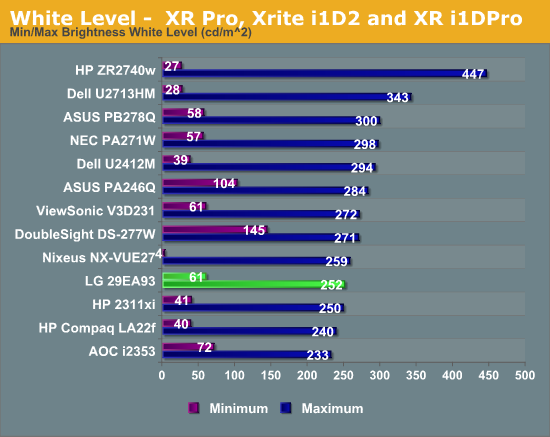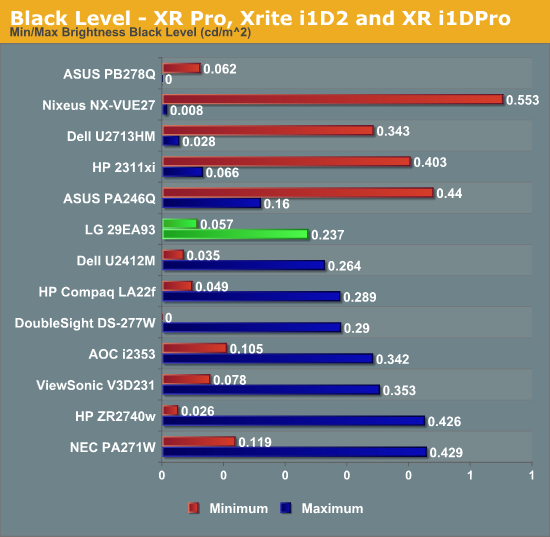LG 29EA93 Ultrawide Display - Rev. 1.09
by Chris Heinonen on December 11, 2012 1:20 AM ESTLG 29EA93—Brightness and Contrast
The LG 29EA93 uses a totally different panel and backlighting setup than any display that I’ve tested, so for once I am coming into a review without any real idea of how something will perform. With the LED backlight set to maximum with a pure white screen, the peak brightness measures at 252 nits. This is a bit lower than I expect but fine for those people without direct sunlight on the screen. With the backlight at minimum that light output level drops down to 61 nits, which provides plenty of range for users that have light controlled environments and want a dimmer display.

Black levels on the LG are pretty good in comparison to other IPS panels. The black level with the backlight at minimum is a nice 0.237 nits, and that drops all the way down to 0.057 nits with the backlight at minimum. When measured against the peak light levels and against other IPS displays, these are good black levels to see.

These numbers combine to give us a contrast ratio over 1060 for both minimum and maximum backlight levels. This puts the LG up there with the best IPS contrast ratios we have measured on any size display. The best VA displays still perform better, but IPS has managed to really improve upon contrast ratios the past few years.

Overall the peak brightness left a bit to be desired on the LG 29EA93, but the black levels and contrast ratio help to make up for that. They still won’t make it a good choice for someone that has to deal with direct sunlight on the display, but for users without that you can get plenty of brightness and a good contrast ratio from it.










90 Comments
View All Comments
justniz - Wednesday, December 12, 2012 - link
The lack of 3D support seems like an obvious oversight, especially for a monitor that obviously targetted for movie and gaming use.I dont use 3D that much but I certainly wouldnt limit myself further by buying a monitor that couldnt support it at all.
cheinonen - Thursday, December 13, 2012 - link
Not having 3D is likely for a couple reasons:- Very few scalers actually work with a 3D picture. A Lumagen Radiance does, but that's $2000 to start with a basic model, and very few projectors with anamorphic mode support can do it to 3D. That would require a lot of extra power and push the price up.
- If they went passive 3D (which LG usually does), that's introducing a texture onto the screen that many people, like myself, can not tolerate on non-3D content.
Given that adding 3D would push the costs up a good amount probably, I think it's a pretty easy thing to drop.
Cannyone - Wednesday, December 12, 2012 - link
I recently found myself in need of a new display for my computer. And I was very interested in this new model. But I was afraid that some games wouldn't be able to utilize it. And I also worried that the input lag might be intrusive. So I ended up settling on the Asus PB278Q. Which I'm happy to say is working out quite well.I personally still wish I could get something like Vizio's Cinemawide TV for watching movies. But that will have to wait. However I commend LG for at least trying to fill this market niche. Its nice to see some companies that aren't afraid to take some risks.
SunLord - Wednesday, December 12, 2012 - link
Anandtech needs to review the Dell UltraSharp U2713HM same idea as this but it has display-port out so we can get some 6 display eyefinity going!peterfares - Wednesday, December 12, 2012 - link
In my opinion these are just stupid. A 27" 2560x1440 monitor is far better. Same horizontal room, more vertical room. 1080 vertical is pretty cramped once you get used to more.audioman83 - Thursday, December 13, 2012 - link
screen space-wise, how is this not better than 1920x1080????? more is more.Calista - Thursday, December 13, 2012 - link
I agree with Chris that a 27" is a better choice, but as compared to a 1920x1080-monitor it makes a lot of sense. 1920 by itself is just silly to work with in most cases, 1920 divided by two is only 960, far from enough for two work areas side by side. A browser need at least 1024 pixels, but even 1200 pixels is often a bit lacking. 2560 divided by two is much more workable.Jsuvexx - Thursday, December 13, 2012 - link
An monitor like this will be snatched up real fast by musicians, and folks in the multimedia industries.ReaM - Monday, January 21, 2013 - link
Anandtech crowd is a lot smarter than the rest of internet. I read a lot about 16:9 vs 16:10 back then when it came and people made ridiculous arguments for 16:9 stating that it's good for movies etc (while no movie has ever been shot in 16:9).If not for the loss of pixels I would vote for 16:9 but 1080 on these monitors is not much bigger than 1280x1024 what I had on my CRT 12 years ago. There is not really much more space on monitors, unless you get one of 1200 or 1440. I used to have the 27" iMac, it was nice, lots of space on the monitor.
dim.thelights - Thursday, April 4, 2013 - link
How to know which Rev. you will buy in the shop?Anyone know how to find out?